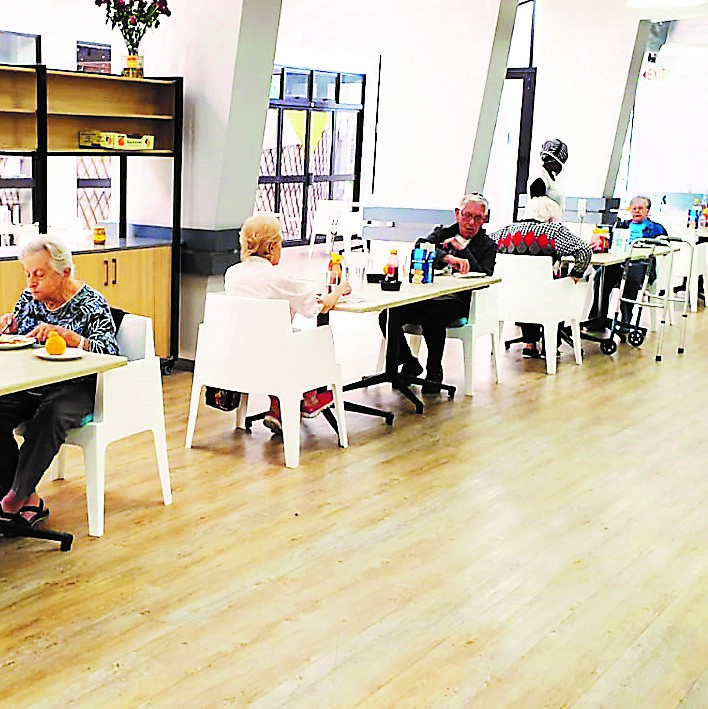click to dowload our latest edition
CLICK HERE TO SUBSCRIBE TO OUR NEWSLETTER


Published
4 years agoon
By
adminNICOLA MILTZ
“That first call rocks you,” said Tomson, “I heard about it on yom tov. It was a shock, but it was a call we had been preparing for.”
He swung into action, and walked the kilometre it took to get to the aged home to make sure that all hands were on deck in the face of the potentially life-threatening crisis.
Sandringham Gardens and the other institutions of the Chevrah Kadisha went into early shutdown and isolation on 13 March well before President Cyril Ramaphosa imposed it on the nation. The idea was to safeguard elderly residents and those most vulnerable to COVID-19 as much as possible.
Because of the early interventions, the Sandringham Gardens shul was the only institution in the community that continued to have regular minyanim throughout the pandemic.
As the world’s synagogues shut their doors, it became a beacon of hope to many as elderly residents said kaddish on behalf of Jews locally and internationally. To date, the shul says kaddish for 1 200 people, and has named 15 baby girls since the start of the lockdown for families as far afield as Uruguay, said resident Rabbi Jonathan Fox, the group rabbi of the Chevrah Kadisha.
So, when the news spread that a resident had contracted the dreaded virus, the little haven of health and wellness for hundreds of elderly residents – including Holocaust survivors – was flung into crisis-control overdrive.
“Many of my staff were celebrating Good Friday, for others it was yom tov, everyone was in some way celebrating with their families. We have a protocol about how to reach me if there is an emergency. By the time I got to Sandringham Gardens, all my senior staff were already in action as well as experts from the private sector who had been brought in to consult to us, and protocols were being implemented. We were prepared, we had discussed scenarios. Everything was in place.”
The rest of the community got wind of the corona scare only after Shabbos on Saturday night, by which time the institution was already nearly two days into managing the crisis.
The home initiated the investigation on Thursday, 9 April. A resident had recently undergone surgery, and the home was subsequently notified that the surgeon who performed the procedure had tested positive for coronavirus.
The patient was recuperating from his surgery in the acute ward at Sandringham Gardens. He was tested, and the result was negative for COVID-19.
“As a precaution, all those who had resided in that acute ward with him were also tested. From that set of tests, one of the Sandringham Gardens residents tested positive for COVID-19. The resident was – and still is – completely asymptomatic, meaning that he is in perfect health and showing no symptoms related to coronavirus. Nonetheless, he was transferred to hospital for ongoing monitoring and isolation,” said Tomson.
The institution has since carried out 76 tests including on 58 staff members and 16 elderly residents, all of which have been negative. The 16 residents have been kept in isolation at Sandringham Gardens, a process which hopefully ends this week.
The chev accommodates nearly 1 000 elderly residents in its facilities, who average 88 years old. Many are frail and require constant nursing care.
“The hardest part is to walk the fine line between being extremely vigilant about safety protocols and the psychosocial needs of residents. Many people in our care suffer from psychiatric conditions, and isolation and loneliness can cause all sorts of other concerns. The difficult part is finding the fine balance between maintaining the strictest protocols from a care, hygiene, access, and social gathering point of view, and achieving some sense of normality and structure in their lives. This is challenging.”
In a letter to residents and their families, the organisation explained how Sandringham Gardens had moved swiftly to deep clean the acute unit and other affected areas using high-tech equipment and standard hospital protocols. Additional cleaners were allocated to deep clean common areas. Tomson said the organisation focused on areas which might pose a higher risk, namely stair railings, light switches, and elevator buttons.
Staff consulted virologists and medical personnel daily. Breakfast and lunch sessions were divided up into three different time slots to ensure fewer people in the dining room. Dinner was served to residents in their rooms. The Nosh Café, a popular gathering point for residents, was no longer furnished with tables and chairs to ensure less congregating. Furniture was removed from smaller lounges in assisted living and frail-care units to prevent people from gathering. Residents were asked to remain in their rooms as much as possible.
Activities take place in smaller groups. Counselling services and other activities have ceased for bigger groups, Tomson said.
Following the scare, the home continues to screen staff at every entrance daily, taking their temperature and checking that they are in good health.
“We have identified a small group of high-risk contact staff whose duties take them throughout the facilities. They will be tested on a weekly basis as a precautionary measure.” Random testing will be conducted on residents and staff as a precaution.
“Our social-services team is being vigilant about which residents might be in need of additional emotional support and counselling at this time,” Tomson said.
Residents who require vital hospital procedures are being kept in isolation for 14 days after their discharge.
Tomson commended the dedication of his staff during this “difficult and challenging period”.
At the time of going to press, the home hadn’t had any more positive tests for COVID-19.
